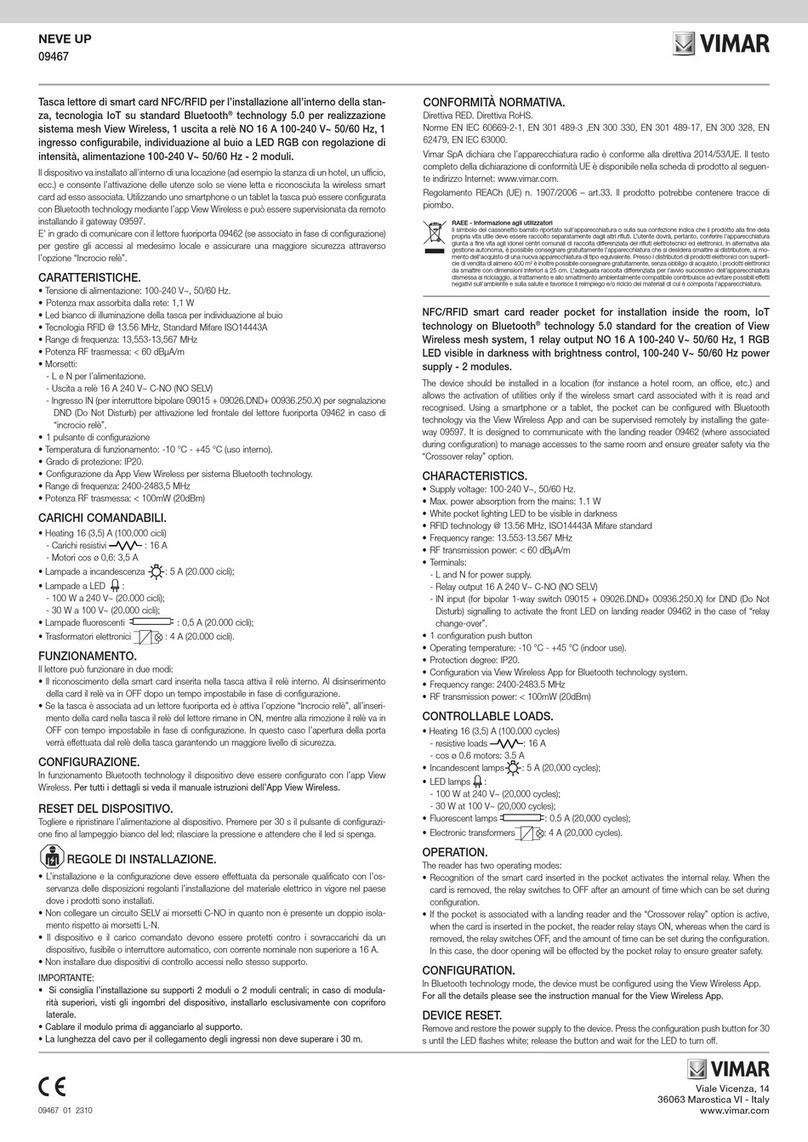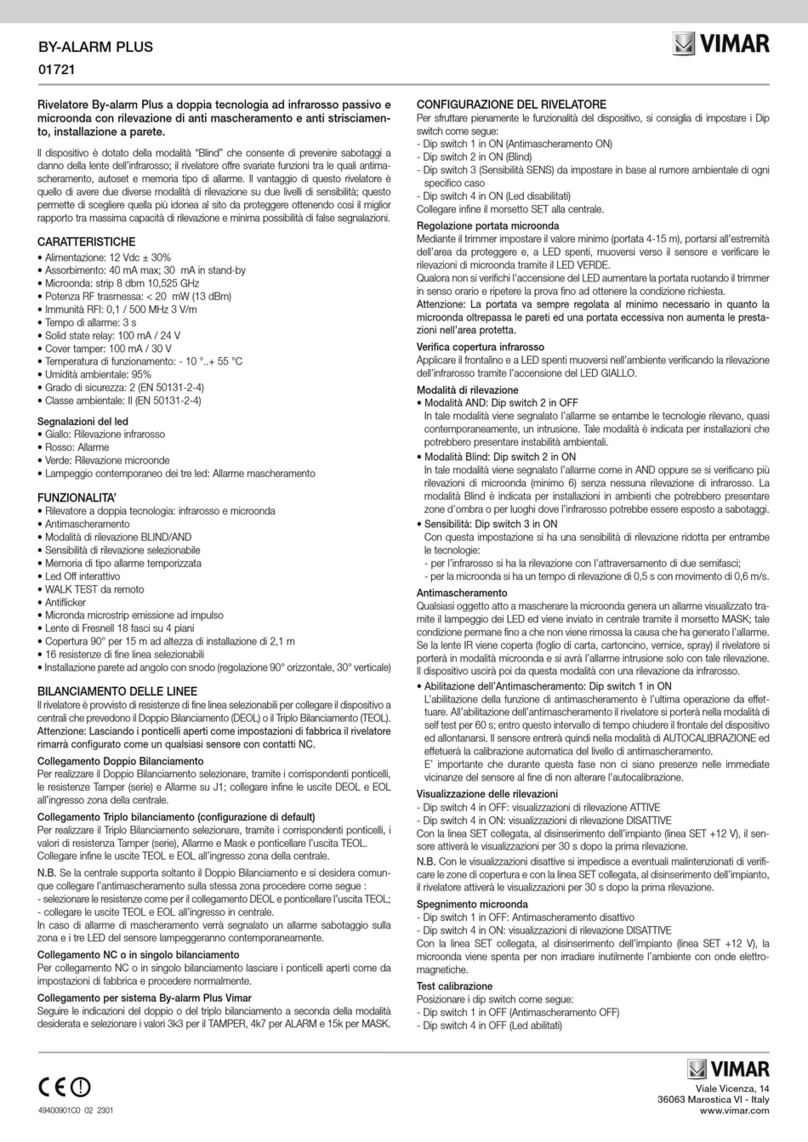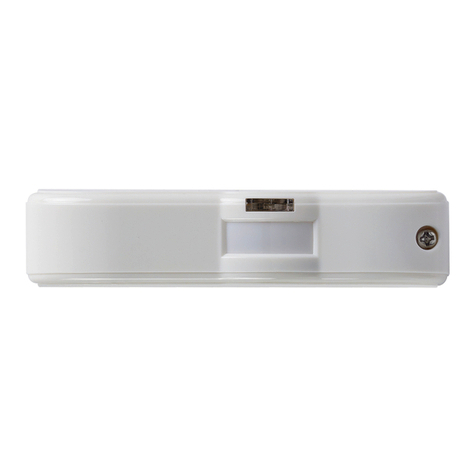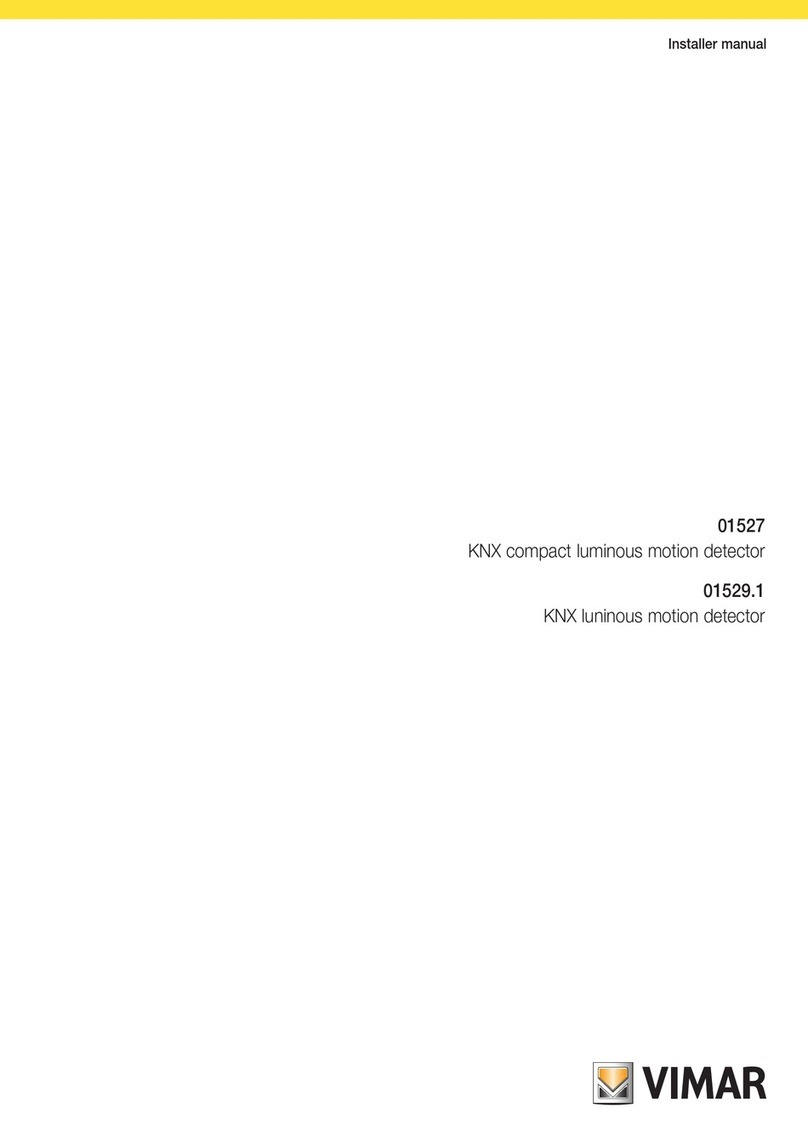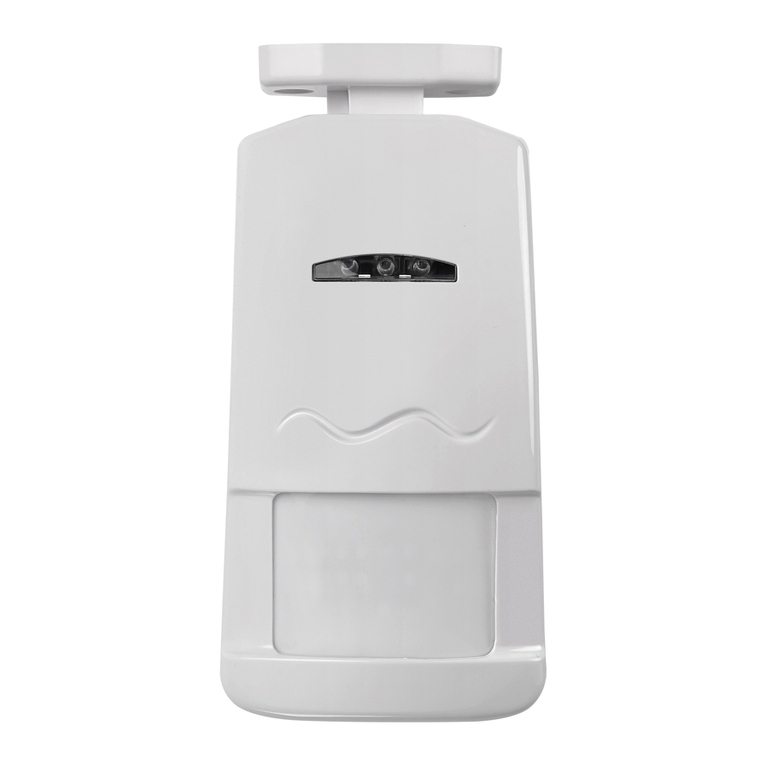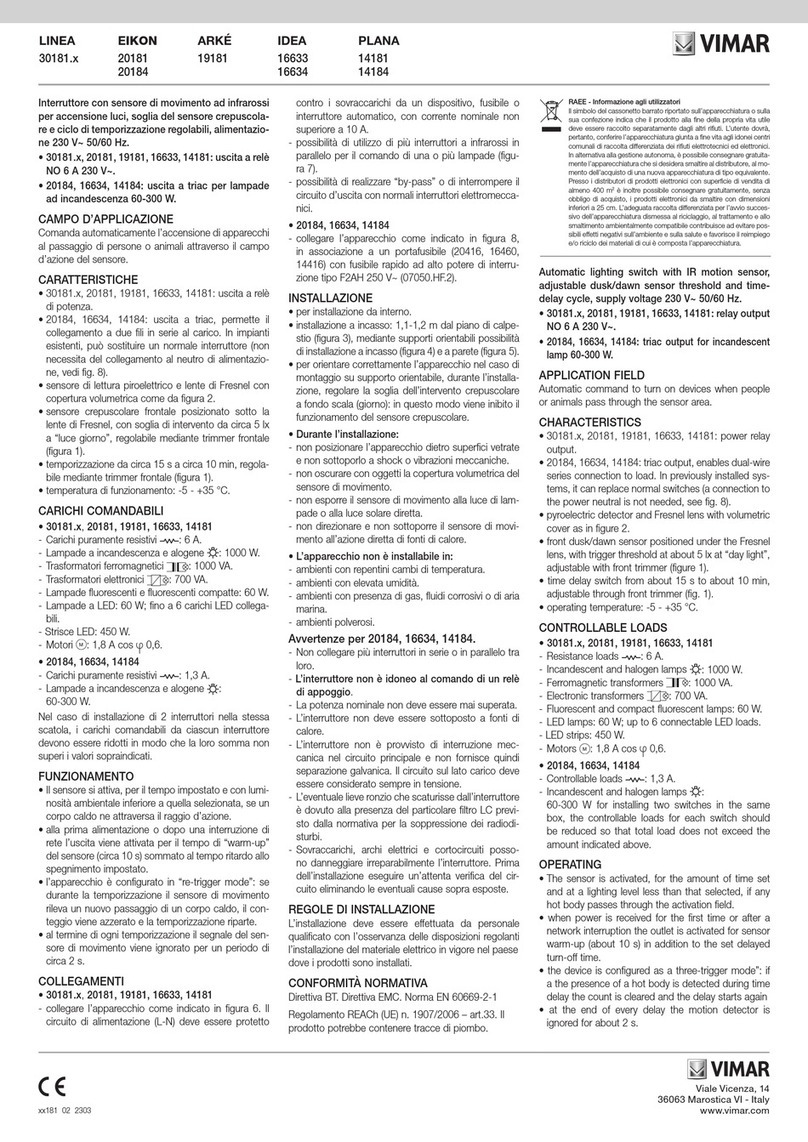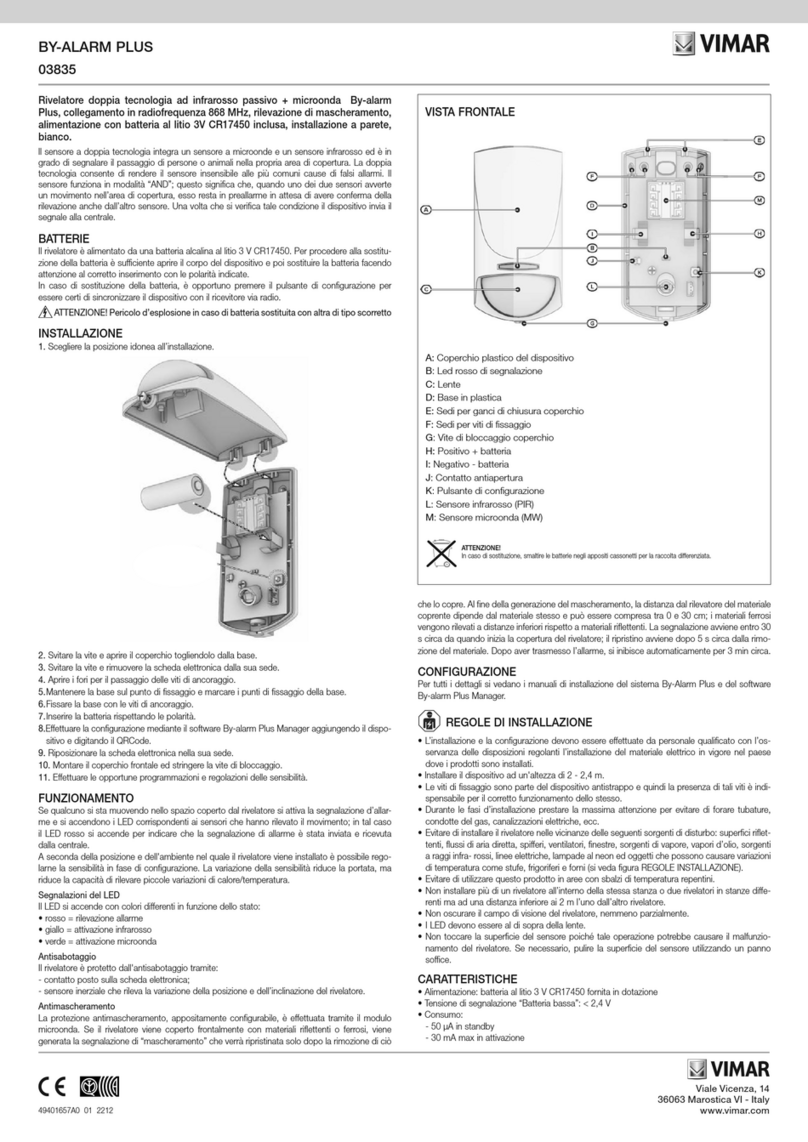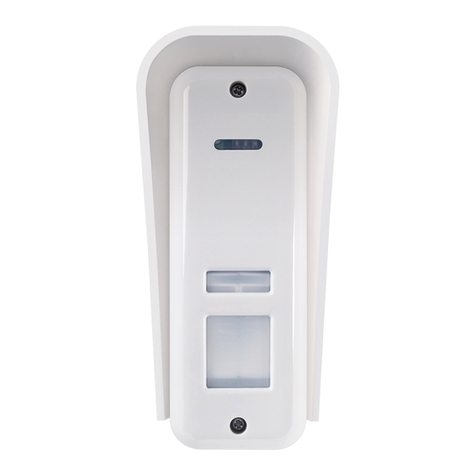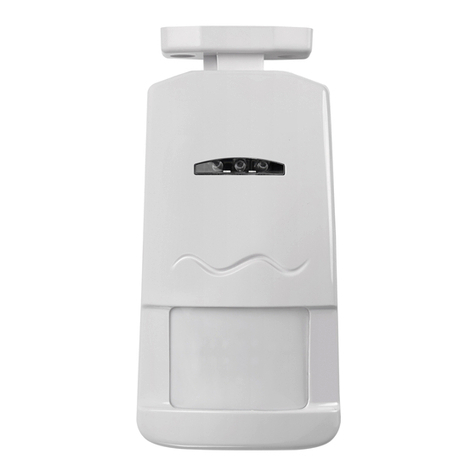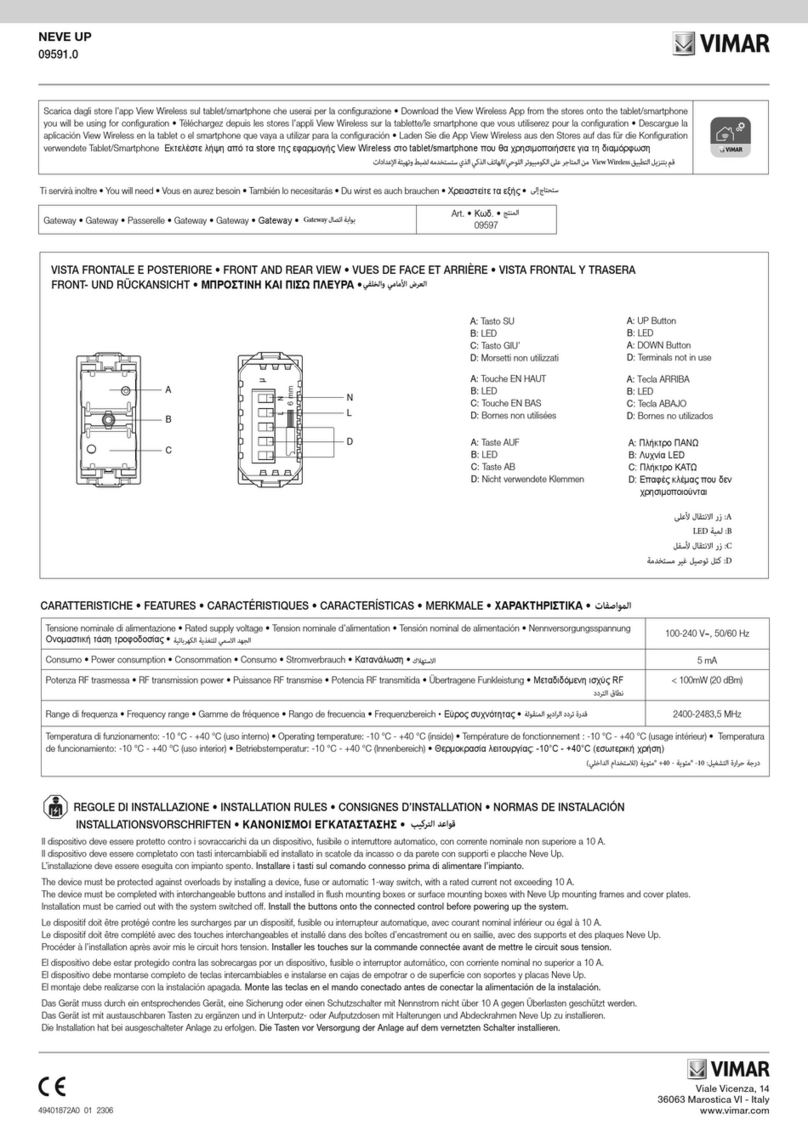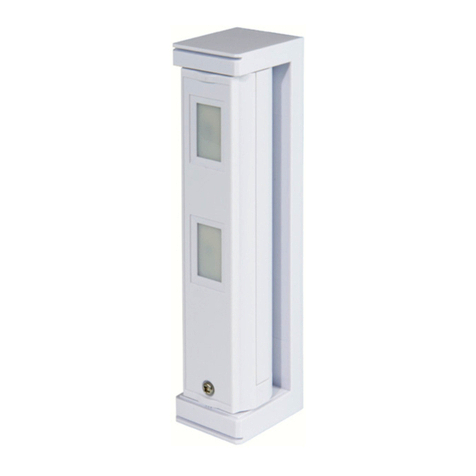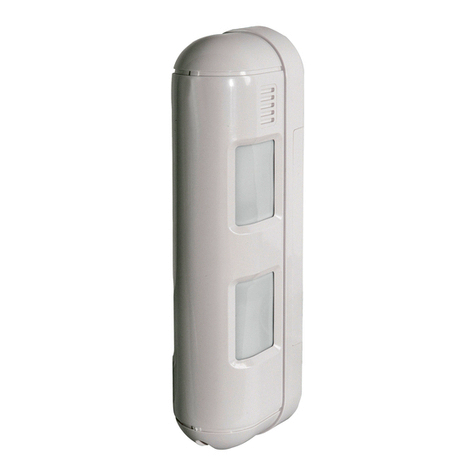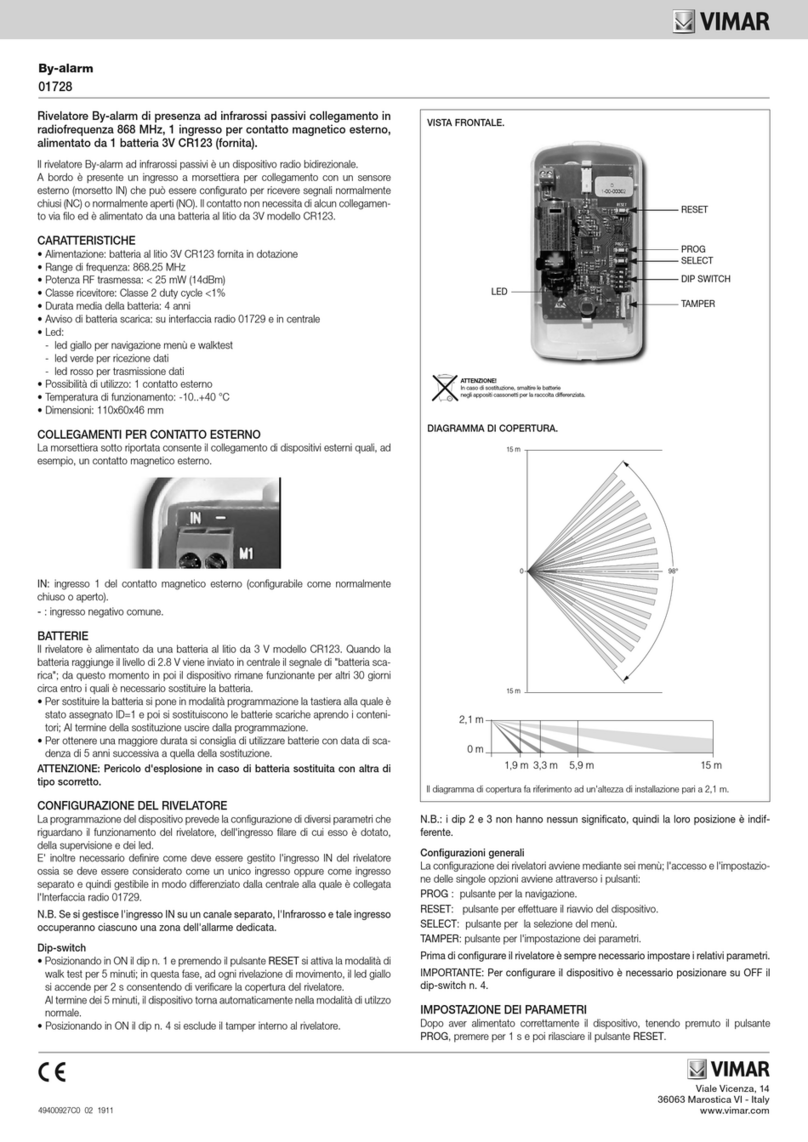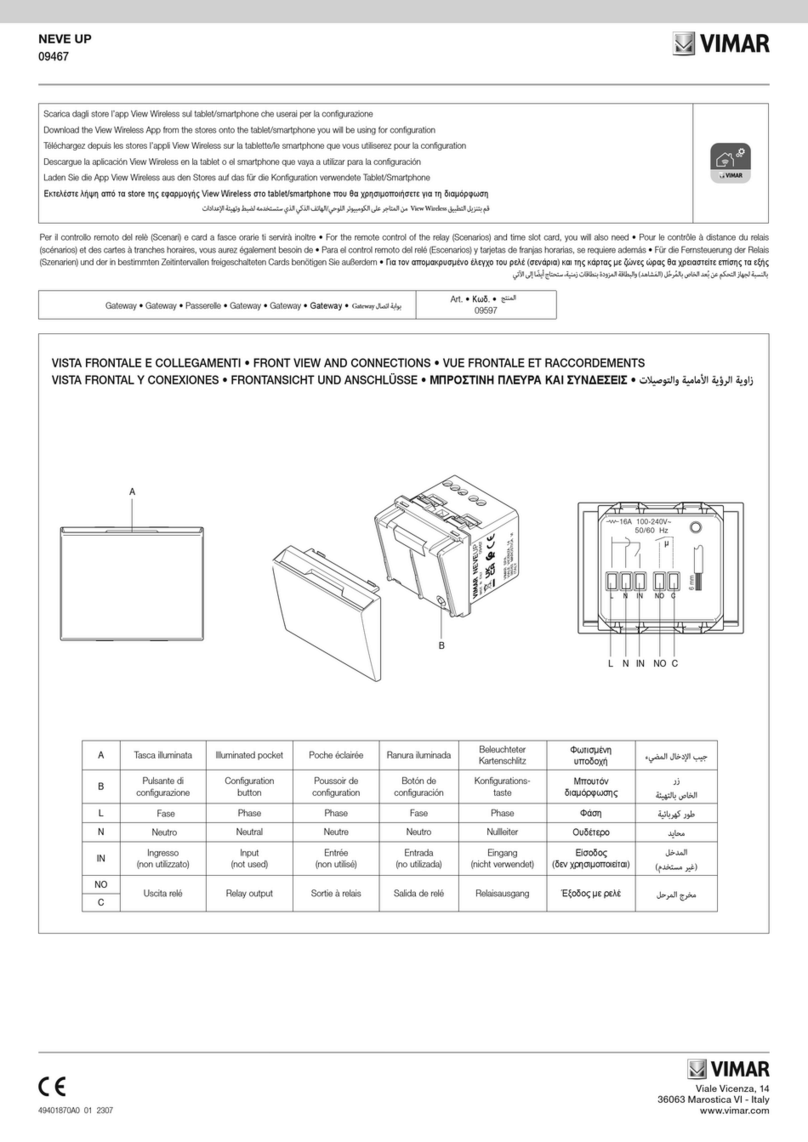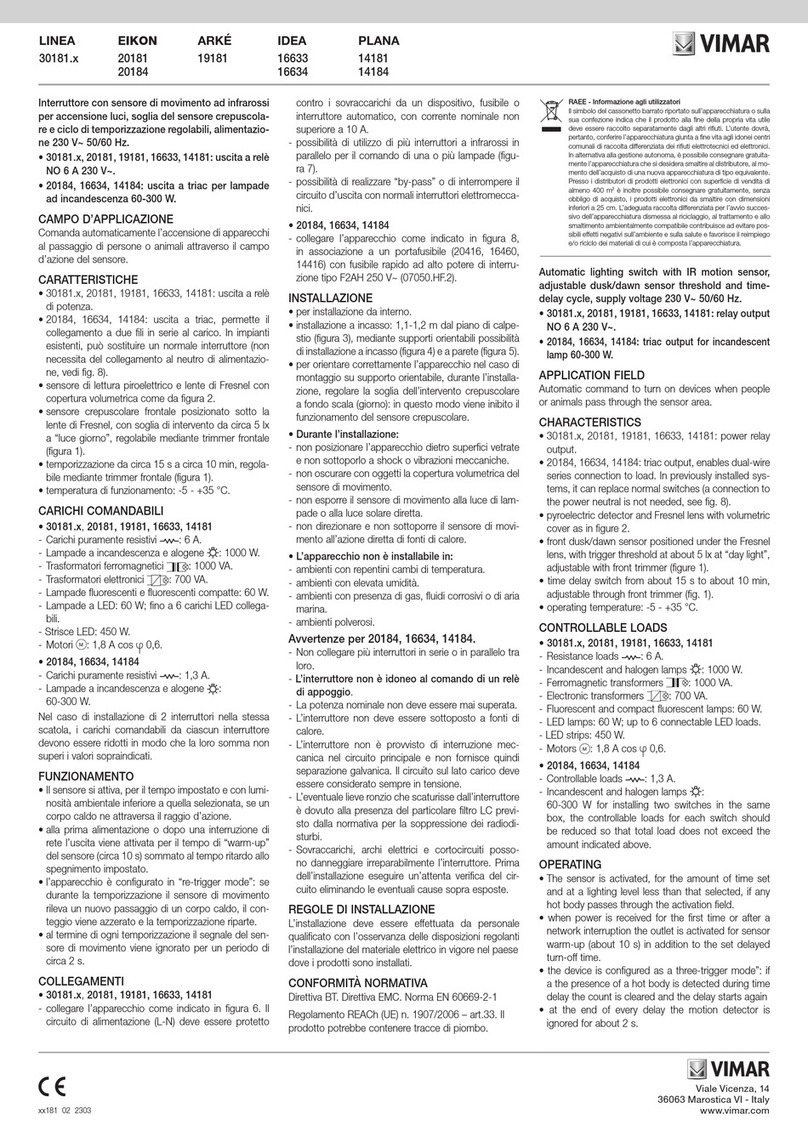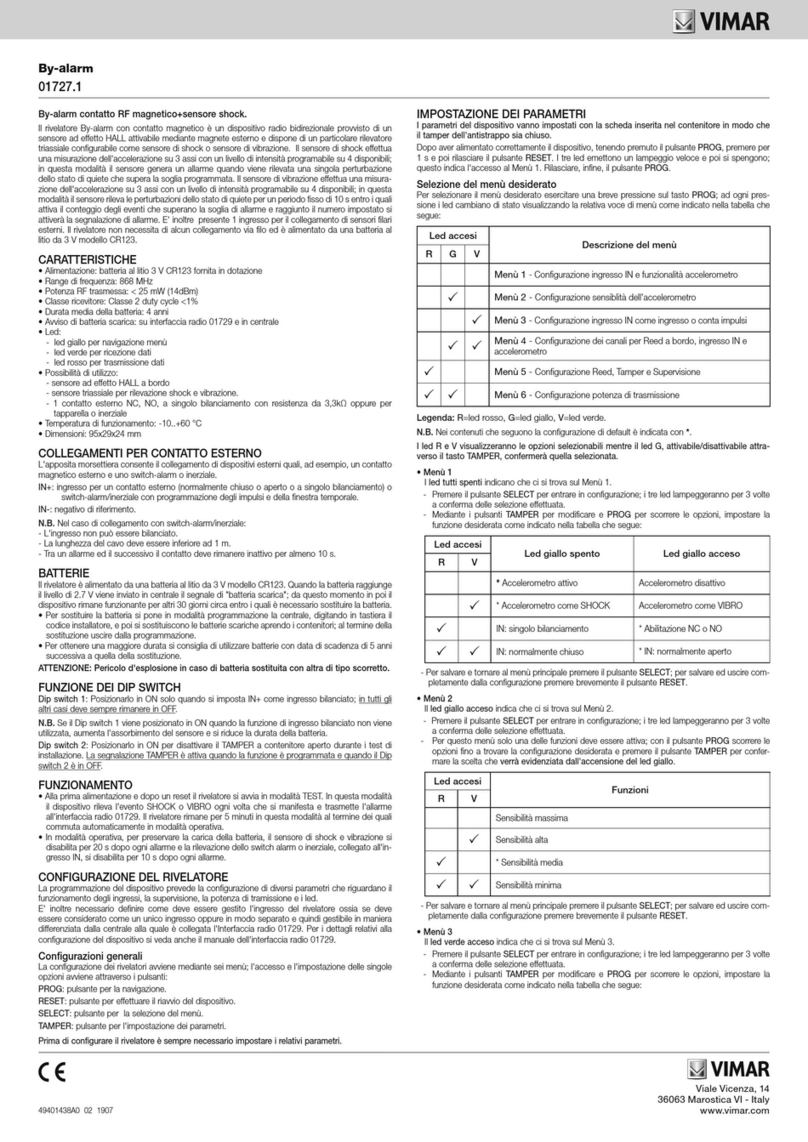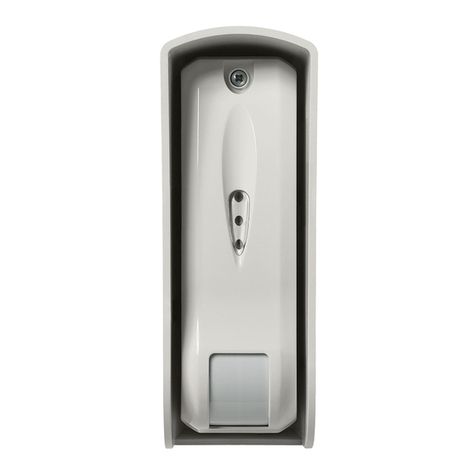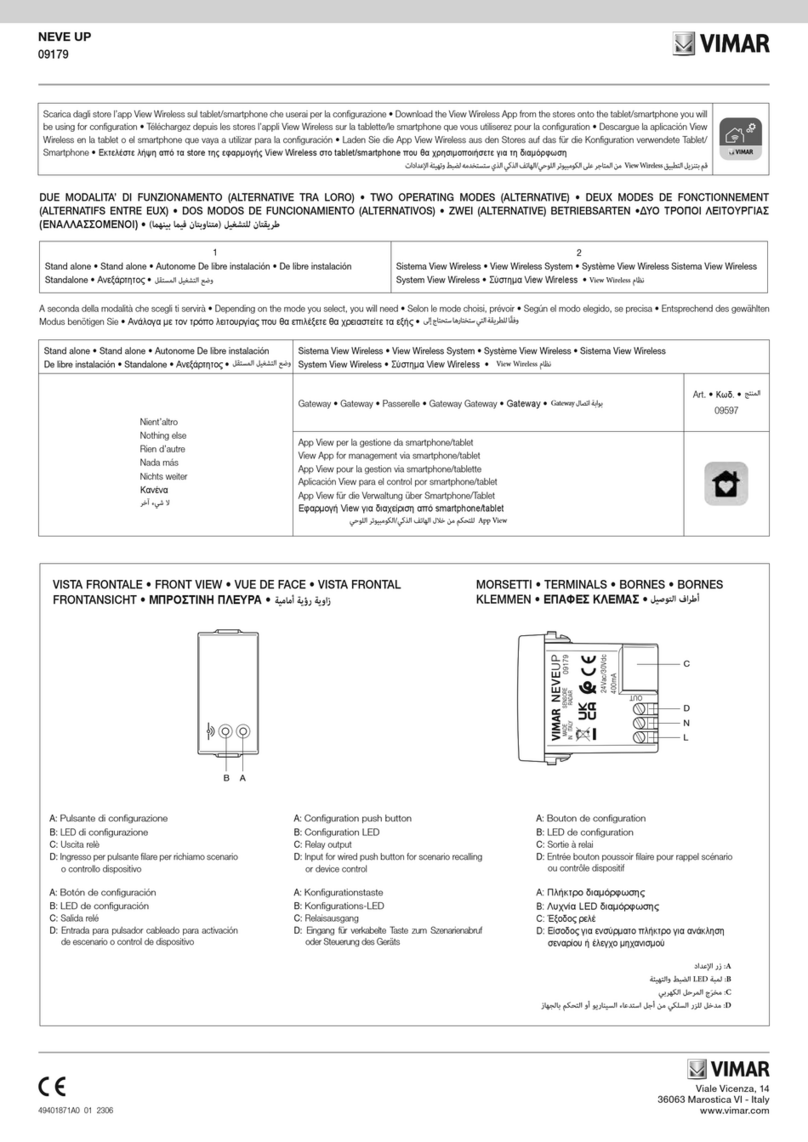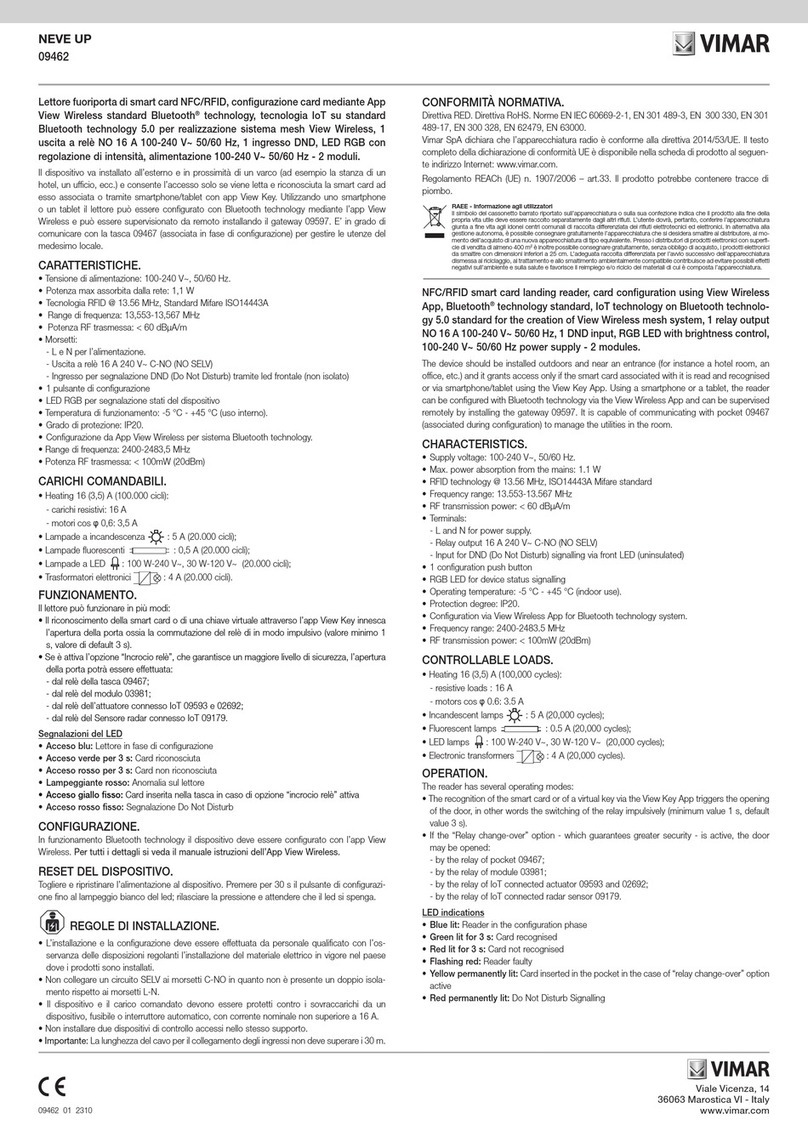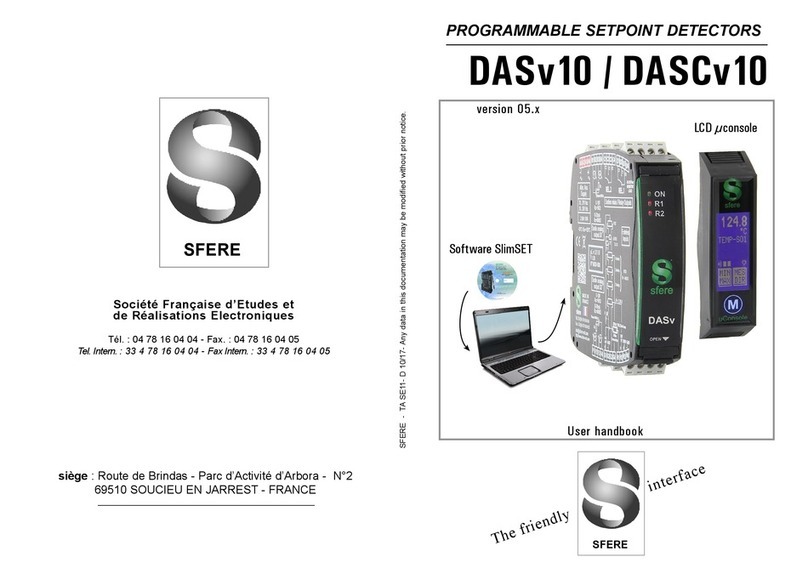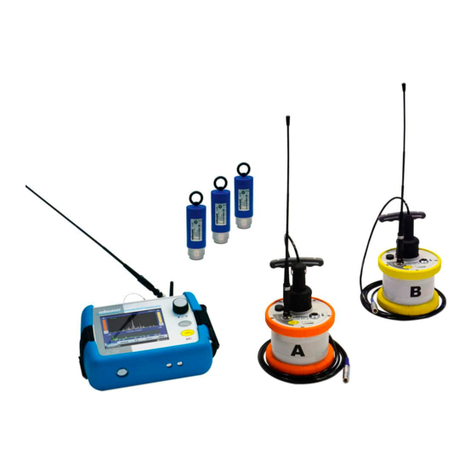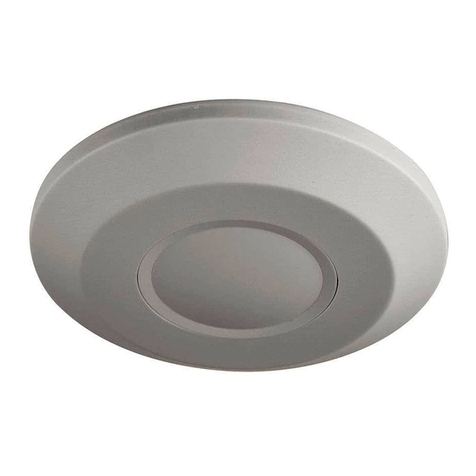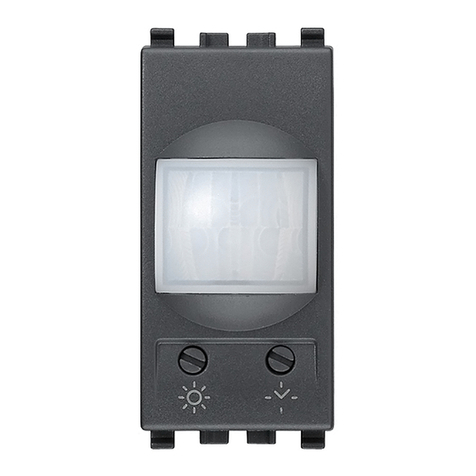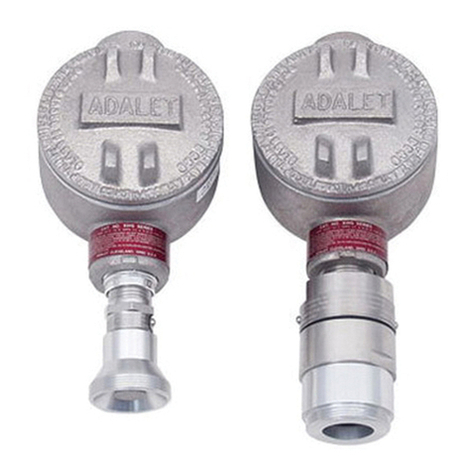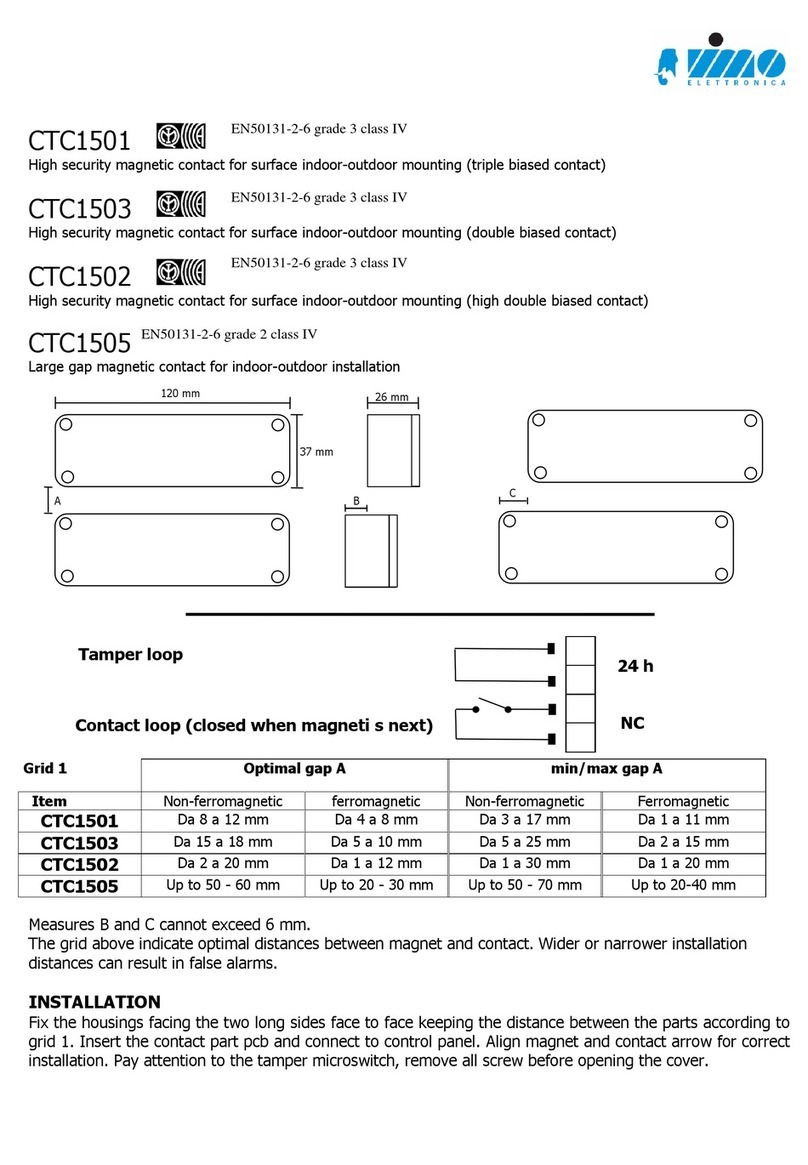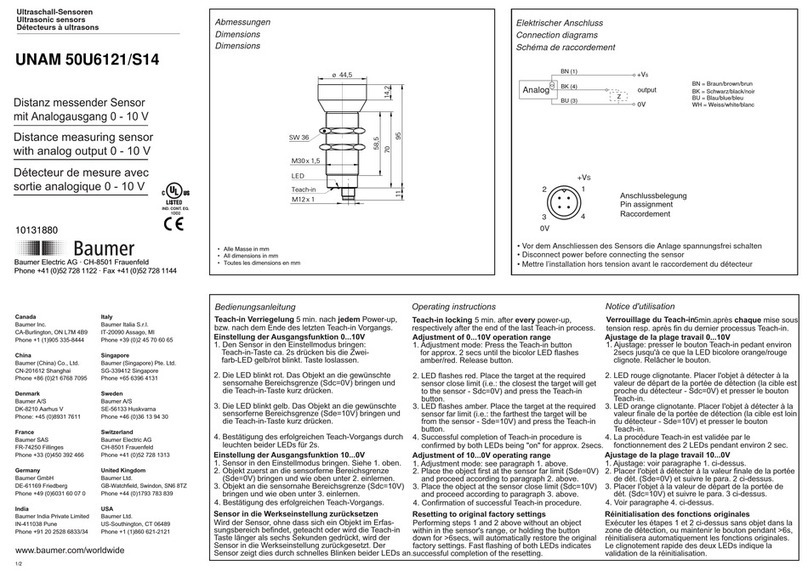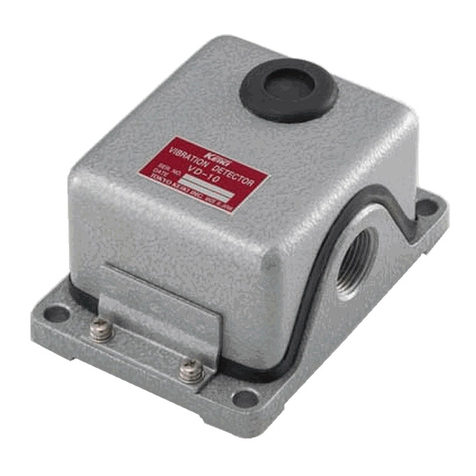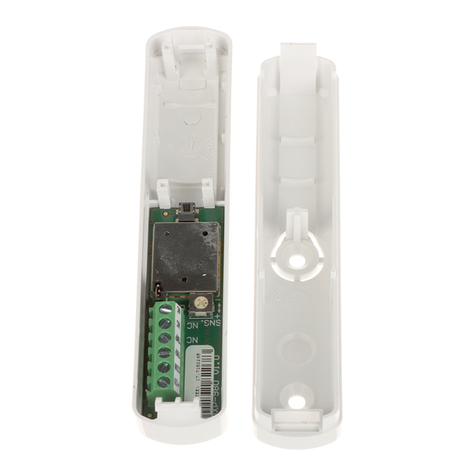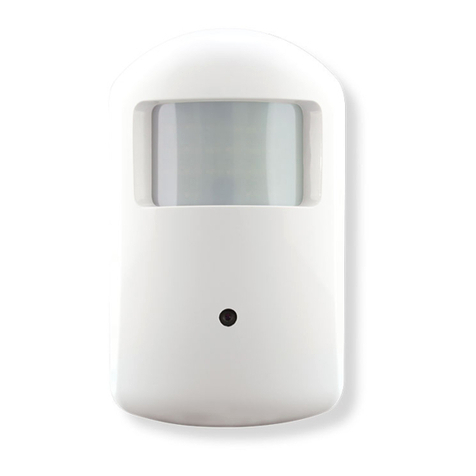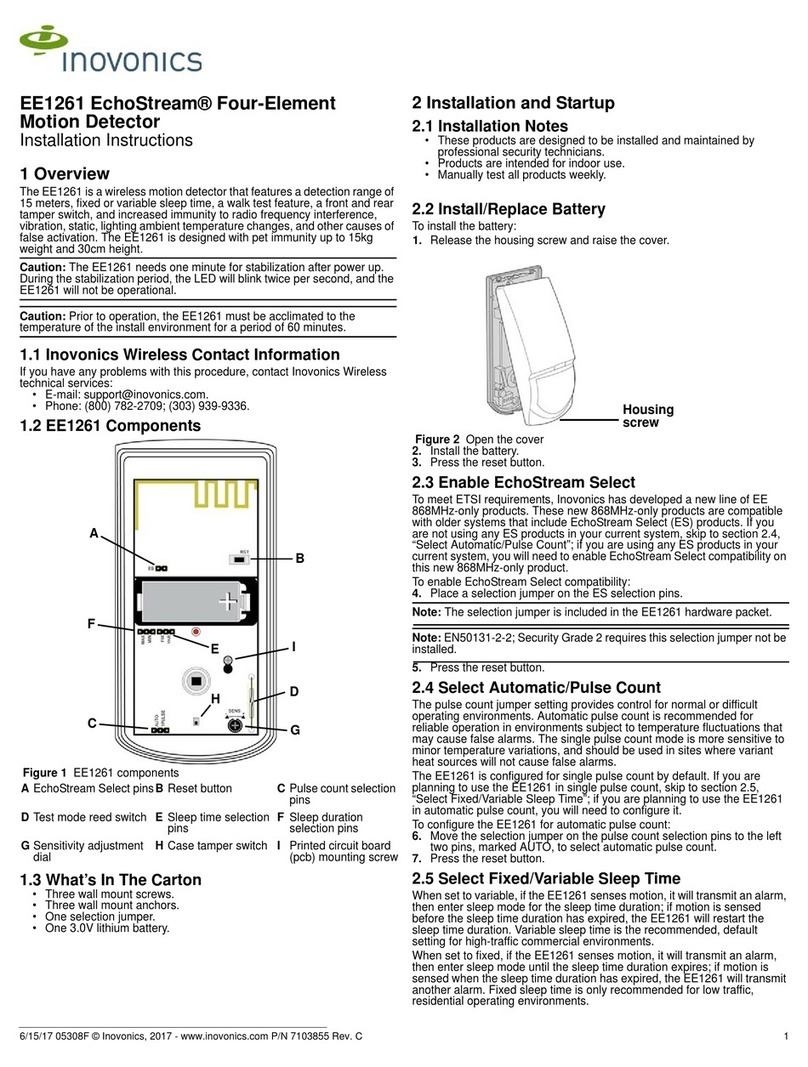
Viale Vicenza, 14
36063 Marostica VI - Italy
www.vimar.com
49401437A0 02 1907
By-alarm
01726
Rivelatore By-alarm a tenda per la protezione di varchi ed infissi quali porte, fine-
stre, terrazzi coperti, corridoi di passaggio e vetrate, collegamento in radiofrequenza
868 MHz, installazione a parete, alimentato da 1 batteria litio 3 V CR2477 (fornita).
Il rivelatore è un dispositivo radio bidirezionale in grado di effettuare rilevazioni con copertura a tenda
all’interno di aree specifiche e spesso problematiche come quelle tra finestra o porta-finestra e chiusura
(tapparella o scuro) con interposta zanzariera. Il dispositivo effettua rilevazioni di tipo termico e opera su
una complessa rilevazione analoga a quella effettuata dalle termocamere. Il sensore effettua continua-
mente analisi su centinaia di punti di rilevazione termica della sua area visibile adeguando costantemente,
grazie ad uno speciale algoritmo dinamico di calcolo, le curve di rilevazione risultanti dal movimento di
un eventuale intruso nell'area interessata e dalla sua permanenza in essa per un intervallo di tempo pro-
grammabile. Dopo una serie di elaborazioni, la combinazione coincidente (AND) delle due curve risultanti
genera l'attivazione dell'allarme. L'algoritmo di calcolo dinamico adegua costantemente le variabili a fron-
te della variazione della temperatura ambiente elaborando e regolando la rilevazione secondo la modalità
di apprendimento DAL (Dynamic Adaptive Learning). Il rivelatore non necessita di alcun collegamento via
filo ed è alimentato da una batteria al litio da 3 V modello CR2477.
CARATTERISTICHE
• Alimentazione: batteria al litio 3 V CR2477 fornita in dotazione
• Range di frequenza: 868.25 MHz
• Potenza di trasmissione: 3dBm max
• Classe ricevitore: Classe 2 duty cycle <1%
• Portata: 1000 m in campo libero
• Copertura del sensore: 120° in verticale, 4° in orizzontale
• Portate del sensore:
- configurazione varco: 2,40 m
- configurazione finestra: 1,40 m
• Durata media della batteria: 2 anni
• Avviso di batteria scarica: su interfaccia radio 01729 e in centrale
• Led:
- led giallo per navigazione menù
- led verde per ricezione dati
- led rosso per trasmissione dati
• Temperatura di funzionamento: -5..+50 °C
• Dimensioni: 97x35x17 mm
BATTERIE
Il rivelatore è alimentato da una batteria al litio da 3 V modello CR2477. Quando la batteria raggiunge
il livello di 2.7 V viene inviato in centrale il segnale di "batteria scarica"; da questo momento in poi il
dispositivo rimane funzionante per altri 30 giorni circa entro i quali è necessario sostituire la batteria.
• Per sostituire la batteria si pone in modalità programmazione la centrale, digitando in tastiera il codice
installatore, e poi si sostituiscono le batterie scariche aprendo i contenitori; al termine della sostituzione
uscire dalla programmazione.
• Per ottenere una maggiore durata si consiglia di utilizzare batterie con data di scadenza di 3 anni
successiva a quella della sostituzione.
ATTENZIONE: Pericolo d'esplosione in caso di batteria sostituita con altra di tipo scorretto.
FUNZIONE DEI DIP SWITCH
Dip switch 1: In posizione ON attiva la funzione di Walk Test
Dip switch 2: Imposta la durata della permanenza nell'area protetta
Walk Test
Posizionando in ON il Dip switch 1 e premendo il pulsante RESET si attiva la funzione di Walk Test per
verificare il funzionamento del rivelatore:
- il led rosso rileva il movimento
- il led verde rileva la presenza
- il led Giallo segnala l'allarme
Dopo 5 s dallo spegnimento del led giallo, il dispositivo è pronto per una nuova rilevazione.
La funzione di Walk Test si disattiva automaticamente dopo 5 min; per attivare un nuovo ciclo di Walk
Test premere il pulsante RESET.
Nota: Durante il periodo di Walk Test il rivelatore non invia nessuna segnalazione di allarme all'interfaccia
radio 01729; le informazioni vengono visualizzate solamente attraverso i led.
Durata della permanenza
Attraverso il Dip switch 2 è possibile impostare l'intervallo di tempo nel corso del quale viene rilevata
l'eventuale presenza di un intruso.
- Dip switch 2 in OFF: 1 s
- Dip switch 2 in ON: 2 s
Aumentando la persistenza si rende più immune il rivelatore agli sbalzi termici ma al contempo si riduce
la velocità con la quale rileva un'eventuale presenza.
PRIMA ALIMENTAZIONE
Alla prima alimentazione il rivelatore effettua la mappatura termica dell'ambiente per un periodo di circa
1 min; durante questo periodo non si deve provocare nessun tipo di allarme o attraversamento dell'area
di rilevazione. Per eseguire nuovamente la mappatura termica premere il pulsante RESET.
CONFIGURAZIONE DEL RIVELATORE
La programmazione del dispositivo prevede la configurazione di diversi parametri che riguardano il fun-
zionamento, la supervisione, la potenza di trasmissione e i led. Per i dettagli relativi alla configurazione
del dispositivo si veda anche il manuale dell'interfaccia radio 01729.
Configurazioni generali
La configurazione dei rivelatori avviene mediante quattro menù; l'accesso e l'impostazione delle singole
opzioni avviene attraverso i pulsanti:
PROG: pulsante per la navigazione.
RESET: pulsante per effettuare il riavvio del dispositivo.
SELECT: pulsante per la selezione del menù.
TAMPER: pulsante per l'impostazione dei parametri.
Prima di configurare il rivelatore è sempre necessario impostare i relativi parametri.
IMPOSTAZIONE DEI PARAMETRI
Iparametri del dispositivo vanno impostati con la scheda inserita nel contenitore in modo che il
tamper dell'antistrappo sia chiuso.
Dopo aver alimentato correttamente il dispositivo, tenendo premuto il pulsante PROG, premere per 1 s
e poi rilasciare il pulsante RESET.
I tre led emettono un lampeggio veloce e poi si spengono; questo indica l'accesso al Menù 1. Rilasciare,
infine, il pulsante PROG.
Selezione del menù desiderato
Per selezionare il menù desiderato esercitare una breve pressione sul pulsante PROG; ad ogni pressio-
ne i led cambiano di stato visualizzando la relativa voce di menù come indicato nella tabella che segue:
Led accesi Descrizione del menù
R G V
Menù 1
- Configurazione Funzione, Blind Time e Led
Menù 2 -
Configurazione della sensibilità del dispositivo
Menù 3 -
Configurazione delle modalità di rilevazione
Menù 4 -
Configurazione della finestra temporale
Menù 5 -
Configurazione del Tamper e della Supervisione
Menù 6 -
Configurazione della Potenza in trasmissione
Legenda: R=led rosso, G=led giallo, V=led verde.
N.B. Nei contenuti che seguono la configurazione di default è indicata con *.
I led R e V visualizzeranno le opzioni selezionabili mentre il led G, attivabile/disattivabile attraverso
il tasto TAMPER, confermerà quella selezionata.
•Menù 1
I led tutti spenti indicano che ci si trova sul Menù 1.
- Premere il pulsante SELECT per entrare in configurazione; i tre led lampeggeranno per 3 volte a
conferma delle selezione effettuata.
- Mediante i pulsanti TAMPER per modificare e PROG per scorrere le opzioni, impostare la funzione
desiderata come indicato nella tabella che segue:
Led accesi Led giallo spento Led giallo acceso
R V
* Configurazione Finestra Configurazione Varco
* Blind Time: 4 min Blind Time: 2 min
* Led Accesi in trasmissione e ricezione Led sempre spenti
- Per salvare e tornare al menù principale premere il pulsante SELECT; per salvare ed uscire comple-
tamente dalla configurazione premere brevemente il pulsante RESET.
•Menù 2
Il led giallo acceso indica che ci si trova sul Menù 2.
- Premere il pulsante SELECT per entrare in configurazione; i tre led lampeggeranno per 3 volte a
conferma delle selezione effettuata.
- Per questo menù solo una delle funzioni deve essere attiva; con il pulsante PROG scorrere le
opzioni fino a trovare la configurazione desiderata e premere il pulsante TAMPER per confermare
la scelta che verrà evidenziata dall'accensione del led giallo.
Led accesi Funzioni
R V
Liv. 1: Sensibilità massima
* Liv. 2: Sensibilità alta
Liv. 3: Sensibilità media
Liv. 4: Sensibilità minima
- Per salvare e tornare al menù principale premere il pulsante SELECT; per salvare ed uscire comple-
tamente dalla configurazione premere brevemente il pulsante RESET.
Nota. Per finestre con altezza fino a 1,4 m si consiglia di impostare il Liv. 2.
Per varchi con altezza fino a 2,4 m si consiglia di impostare il Liv. 2.
•Menù 3
Il led verde acceso indica che ci si trova sul Menù 3.
- Premere il pulsante SELECT per entrare in configurazione; i tre led lampeggeranno per 3 volte a
conferma delle selezione effettuata.
- Per questo menù solo una delle funzioni deve essere attiva; con il pulsante PROG scorrere le
opzioni fino a trovare la configurazione desiderata e premere il pulsante TAMPER per confermare
la scelta che verrà evidenziata dall'accensione del led giallo.
Led accesi Funzioni
R V
* Rilevazione di 1 evento generico
Rilevazione di 2 eventi generici
Rilevazione di 1 eventi ingresso + 1 evento uscita
Rilevazione di 3 eventi generici
- Per salvare e tornare al menù principale premere il pulsante SELECT; per salvare ed uscire comple-
tamente dalla configurazione premere brevemente il pulsante RESET.
Nota. Per evento generico si intende uno qualsiasi tra le seguenti tipologie:
- evento ingresso, ovvero movimento della persona che entra nell’area di rilevazione e rimane
nell’area di rilevazione per un tempo superiore a quello programmato (impostazione da Dip
switch 2);
- evento uscita, ovvero movimento della persona che esce dall’area di rilevazione per un tempo
superiore a quello programmato (impostazione da Dip switch 2).
•Menù 4
Il led giallo e verde accesi indicano che ci si trova sul Menù 4, quello che permette la configurazione
delle finestra temporale.




